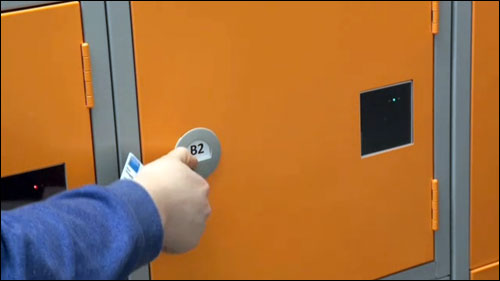Jun 26, 2013London's Kingston University is employing TrackerPoint's TrackCAB solution to automate its after-hours return process, as well as to conduct inventory counts of 2,000 pieces of media equipment, such as cameras, laptops and computers, that it loans out to students and faculty. The solution enables borrowers to return goods outside of business hours, by placing items into RFID-enabled lockers, and also reduces the amount of time required for personnel to take inventory of items stored in the equipment stockroom.
Kingston University loans out media equipment to students and faculty members as needed for coursework. Although there is no charge to borrow these items, there is a fine for returning them late. During the day, the area is manned by workers who check out equipment to students and record each transaction, including the item's serial number and the identity of the student receiving and later returning it. During evening hours and weekends, however, the loans room is closed.

"One of the biggest complaints we had from our users was that they wanted to be able to return items at times when we were unable to keep the loans room open and manned," explains David Rimmer, Kingston University's faculty technical manager.
The university sought a solution that would enable students to return equipment during business off-hours. Without the system, some students were inclined to simply place the equipment outside the borrowing area for the staff to retrieve the next business day, leaving the devices vulnerable to theft.
In addition, the university hoped to find a more efficient method of locating equipment kept in the facility's storage room. Because most goods are stored in a case, each case typically would need to be opened during inventory audits to determine what was contained within.
With the TrackCAB solution, a passive EPC Gen 2 ultrahigh-frequency (UHF) RFID tag (both Omni-ID and Xerafy tags are being used) is permanently attached to each item. When a student needs to return a borrowed camera or other piece of equipment, he proceeds to a cabinet composed of multiple lockers and taps his ID card next to the high-frequency (HF) reader on one of the locker doors. The reader then interrogates the ID number of the card's Mifare RFID chip, after which the TrackCAB software confirms the student's identity—and that he has borrowed equipment—and unlocks the compartment, according to Cliff Evans, TrackerPoint's owner.
The cabinet has a UHF reader-and-antenna network built into it to interrogate each tag of an item placed into one of its compartments. (For competitive reasons, Evans says he cannot describe any additional details regarding the specific readers or antennas installed.) When the item is placed in a cabinet compartment, the TrackerPoint software platform detects that tag's ID number and updates the equipment's status as having been returned. A light-emitting diode (LED) on the door then indicates that the compartment is occupied, so others wishing to return something else will know that that compartment is no longer available to accept a return.
TrackerPoint's TPView software module e-mails a confirmation to the student who has returned the equipment. It also sends a daily summary e-mail to the university's supervisory staff, indicating which items have been returned, as well as any that have not been returned as expected. Supervisors can then view a real-time inventory status update by signing into the TPView application, where they can not only see what has been checked out and when it is slated to be returned, but also receive reports, provided that they have configured the system to supply such details as how often specific equipment is checked out.
Upon returning to work at the beginning of the next business day, employees retrieve all equipment from the cabinets and place those items in the storage area, along with all the other goods. The borrowing of equipment by students and faculty has grown due to the cabinet's convenience, Rimmer says.
Media-equipment personnel also utilize a Nordic ID handheld reader, loaded with TrackerPoint's TPMobile software, to perform periodic inventory checks of all tagged items within the storage area.
TPMobile determines whether any items are missing from inventory. What's more, if staff members seek specific items that they cannot manually locate in the loans room, they can put the handheld reader in Geiger counter mode and carry it through the storage area until finding that equipment. The procedure has saved the staff considerable time, Rimmer reports, since workers need not open each box, bag or other container holding a piece of equipment, in order to view the item inside and read its serial number. With RFID, an employee can simply hold the reader near a container to determine its contents.
TrackerPoint offers its solutions to customers worldwide, some of which are currently using TrackCAB to manage files or laundry.


